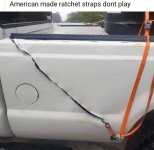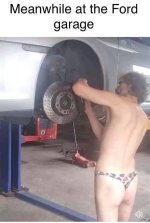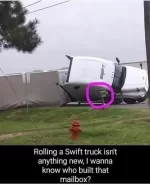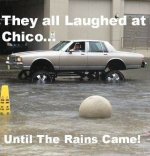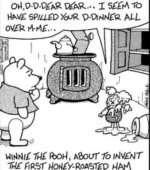Navigation
Install the app
How to install the app on iOS
Follow along with the video below to see how to install our site as a web app on your home screen.
Note: This feature may not be available in some browsers.
More options
Style variation
You are using an out of date browser. It may not display this or other websites correctly.
You should upgrade or use an alternative browser.
You should upgrade or use an alternative browser.
JD'S Memes
- Thread starter ESCO
- Start date
JDMeister
Forum Moderator
- May 1, 2021
- 59,283
- 27,791
DO NOT HUMP does not have any of the off-color significance that seems to give many of the Teeming Millions their principal reason to go on living. It refers to a common method used to sort freight cars known as “humping,” which involves the use of a man-made hill, or hump. A track heads up the hill and branches into numerous parallel tracks on its way down the other side. To make up new trains, a switch engine pushes a string of cars to the top of the hump, where the cars are uncoupled one at a time. Having determined the car’s destination, a worker in a nearby tower pushes buttons or throws levers or whatever to get the track switches (you know, those things where one track divides into two) lined up properly. The car is then given a nudge, causing it to roll down the hump and onto the right track.
The advantage of humping is that it’s a lot faster than having switch engines shuttle back and forth all day making up trains. The disadvantage is that it’s sometimes a little rough on the freight cars and their contents. Occasionally a car derails going down the hill, meaning the crew has to stop working and try to get the wheels back on the rails, which is not much fun, particularly in the middle of winter. What’s worse is the possibility that the car may roll down the hill too fast and crash into the car in front of it, jostling or damaging both the cars and what’s inside them. Special gimmicks on the rails called “retarders” are supposed to slow things down and prevent this, but they have been known to fail. Accordingly, cars with especially delicate contents are marked DO NOT HUMP, which tells the yard crew to set the car aside for special handling. This applies particularly to the tank cars used to haul hazardous chemicals, many of which have DO NOT HUMP stenciled permanently on their sides.
The railroad business, I might note, is one of the few fields where a guy without advanced training can still hope to wreak major environmental havoc. An old high school teacher of mine once told me about the time he worked in the steel mills helping switch coal cars. During his first week on the job, he was asked to participate in a risky maneuver known as a “flying switch.” The idea was that the locomotive would head toward a switch pulling a single coal car behind it. At the right moment, somebody would uncouple the car and the locomotive would scoot ahead through the switch onto the main line. Once the locomotive was clear, my high school teacher was supposed to throw the switch so the coal car would roll onto the side track.
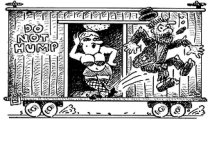
The advantage of humping is that it’s a lot faster than having switch engines shuttle back and forth all day making up trains. The disadvantage is that it’s sometimes a little rough on the freight cars and their contents. Occasionally a car derails going down the hill, meaning the crew has to stop working and try to get the wheels back on the rails, which is not much fun, particularly in the middle of winter. What’s worse is the possibility that the car may roll down the hill too fast and crash into the car in front of it, jostling or damaging both the cars and what’s inside them. Special gimmicks on the rails called “retarders” are supposed to slow things down and prevent this, but they have been known to fail. Accordingly, cars with especially delicate contents are marked DO NOT HUMP, which tells the yard crew to set the car aside for special handling. This applies particularly to the tank cars used to haul hazardous chemicals, many of which have DO NOT HUMP stenciled permanently on their sides.
The railroad business, I might note, is one of the few fields where a guy without advanced training can still hope to wreak major environmental havoc. An old high school teacher of mine once told me about the time he worked in the steel mills helping switch coal cars. During his first week on the job, he was asked to participate in a risky maneuver known as a “flying switch.” The idea was that the locomotive would head toward a switch pulling a single coal car behind it. At the right moment, somebody would uncouple the car and the locomotive would scoot ahead through the switch onto the main line. Once the locomotive was clear, my high school teacher was supposed to throw the switch so the coal car would roll onto the side track.

JDMeister
Forum Moderator
- May 1, 2021
- 59,283
- 27,791
JDMeister
Forum Moderator
- May 1, 2021
- 59,283
- 27,791
Damn, I'm re-posting my own meme's within minutes!
JDMeister
Forum Moderator
- May 1, 2021
- 59,283
- 27,791
JDMeister
Forum Moderator
- May 1, 2021
- 59,283
- 27,791
JDMeister
Forum Moderator
- May 1, 2021
- 59,283
- 27,791
JDMeister
Forum Moderator
- May 1, 2021
- 59,283
- 27,791
JDMeister
Forum Moderator
- May 1, 2021
- 59,283
- 27,791
JDMeister
Forum Moderator
- May 1, 2021
- 59,283
- 27,791

